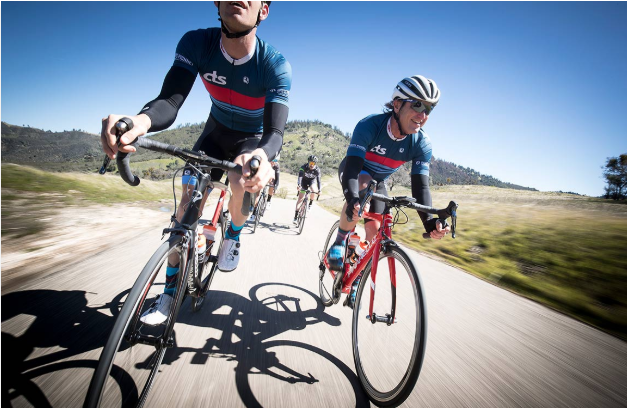 When you think about it, athletes spend far more time not training than they do working out. There are 168 hours in a week, and it is rare for any athlete to train more than 25 hours in a week (15% total). At 12 hours per week, which is a relatively heavy training load for amateur and masters athletes, exercise takes up 7% of your week. Training is important, but what you do with the other 93 percent of your week makes all the difference in how you respond and improve from your training. Of all the products and methods purported to enhance recovery, Coach Chris Carmicheal of CTS Trainright has narrowed them down to his 10 most important rules for athletes.
When you think about it, athletes spend far more time not training than they do working out. There are 168 hours in a week, and it is rare for any athlete to train more than 25 hours in a week (15% total). At 12 hours per week, which is a relatively heavy training load for amateur and masters athletes, exercise takes up 7% of your week. Training is important, but what you do with the other 93 percent of your week makes all the difference in how you respond and improve from your training. Of all the products and methods purported to enhance recovery, Coach Chris Carmicheal of CTS Trainright has narrowed them down to his 10 most important rules for athletes.
While my list would be a bit different.
For example, I am a big fan of regular infrared saunas but that is not a go-to option for most. But I would strongly recommend you use 2 scoops of FUNDAMINOS™ essential amino acids daily to not only meet but enhance your protein recovery. Also look into our 97% protein powder with collagen: PURECLEAN PROTEIN
Most people have a difficult time consuming 120 grams of protein a day without resorting to lower quality protein powders. Each scoop provides the equivalent of 40 grams of protein with less than 5 calories! It is a no brainer. You don’t necessarily need to incorporate every one of them after every workout, but you should include more of them as your efforts get harder, and your overall training workload increases.
When you think about it, athletes spend far more time not training than they do working out. There are 168 hours in a week, and it is rare for any athlete to train more than 25 hours in a week (15% total). At 12 hours per week, which is a relatively heavy training load for amateur and masters athletes, exercise takes up 7% of your week. Training is important, but what you do with the other 93 percent of your week makes all the difference in how you respond and improve from your training.
Of all the products and methods purported to enhance recovery, I’ve narrowed them down to my 10 most important rules for athletes. You don’t necessarily need to incorporate every one of them after every workout, but you should include more of them as your efforts get harder and your overall training workload increases. In no particular order (because priority depends on the circumstances), they are:
Cool Down
During workouts your cardiovascular system moves a tremendous volume of blood every minute. In addition to a higher stroke volume and faster heartbeat compared to rest, skeletal muscle contractions assist in maintaining elevated circulation rate. When your workout is done, your muscles still need elevated circulation to deliver oxygen and nutrients, and to dissipate heat. Taking several minutes to gradually slow down eases the transition back to normal.
Cool Off
Particularly after exercise in a hot environment, whether outdoors or in a warm indoor studio, it is helpful to proactively bring your body temperature down. As mentioned above, a gradual cooldown plays a role by supporting elevated circulation that moves heat from muscles and your core to your skin. Dousing with cool water, wetting your clothing, and covering yourself with wet towels are also effective. Consuming cold beverages or even ice-slurry beverages also help. And one trick I’ve always liked is a “cold rinse” at the end of a post-workout shower. You can read more about cooling protocols in this article.
Rehydrate
It is important to get a good sense for your sweat rate and how much fluid you lost during exercise. You can do this by weighing yourself (naked) before and after your workout. Any weight lost is fluid weight, and you want to consume water and fluids equivalent to 150% of that weight within the 4 hours after your workout. So, if you lost 2 pounds (32 ounces) during exercise, aim to gradually consume 48 ounces in the hours afterward (fluid content of food, like fruit, counts).
Replenish energy
Post-workout nutrition doesn’t need to be overly complicated. Your muscles are primed to replenish depleted carbohydrate stores most rapidly in the hour after training, and taking advantage of the “glycogen window” is a good habit, but it’s only crucial if you are training/competing multiple times per day or sustaining a very heavy training workload. If you are training once per day, your muscle glycogen stores will be fully replenished within 24 hours by eating a balanced whole food diet. The caveat here is that your total daily caloric intake has to be high enough to account for your training expenditure and activities of daily living. Energy deficiencies hinder recovery and hurt exercise performance, so if you are pursuing competing priorities of training for performance and restricting energy for weight loss, understand that the energy restriction is going to negatively affect your training and recovery.
Consume protein throughout the day
While carbohydrate is the most important nutrient for replenishing muscle glycogen stores, protein is critical for supporting muscle repair and growth, as well as immune function. Your body needs a steady supply of protein to handle these tasks, but you can’t store protein the way you can carbohydrate and fat. As a result, it is more effective to consume protein with your meals and snacks throughout the day, rather than concentrating your protein intake to one post-workout feeding or a particular meal.
How much protein should you consume? Endurance athletes should aim for 1.2-1.6 grams of protein per kilogram of bodyweight per day, increasing to about 1.8-2.0 g/kg/day during periods of higher training intensity or volume. Masters athletes (40-55) and aging athletes (55+) will benefit from higher protein intake (2 g/kg/day on a regular basis, slightly higher during periods of higher training workload) due to sarcopenia and reduced muscle protein synthesis (greater protein intake required to synthesize a given amount of muscle protein).
Learn more about our gold-standard protein powder, PURECLEAN PROTEIN.
Utilize Compression/Massage/Foam Roller
These recovery modalities aim to facilitate circulation and reduce post-workout soreness and stiffness. The research into their effectiveness is mixed, but I think there are two indisputable ways they enhance recovery. Number one, they make athletes sit still for a while. Thirty minutes in pneumatic compression boots, or on a massage table, or with a foam roller, is thirty minutes you’re not up running around or moving on to your next task. Number two, if they make you feel good then they work for you. Some of the effectiveness of recovery activities is in your head, yet that doesn’t make it any less real.
Consider CBD for anti-inflammation and pain relief
In recent years, the use of CBD (cannabidiol) has become more widespread for post-workout recovery. One of more than a hundred “phytocannabinoids,” which are unique to cannabis sativa, CBD is not psychoactive and is not prohibited by sport anti-doping agencies. CBD has many therapeutic properties that are being researched by scientists and doctors around the world. It is commonly used by athletes for its anti-inflammatory, pain relief, and calming properties.
While acute inflammation plays an important role in stimulating positive adaptations to training, chronic inflammation does more harm than good. CBD oil, like Relief from Care by Design Hemp, may aid post-workout recovery by helping the body return to homeostasis following the acute inflammation from training. For many athletes, and in my personal experience, CBD oil also reduces post-workout muscle soreness and has a mood-calming effect that makes sleep more restful.
If you are interested in CBD products, I recommend Care by Design Hemp. Here’s why. Thanks to a partnership with the company, you can click this link to automatically save 20% on Care by Design Hemp products at checkout.
Prioritize Sleep
Although this list of recovery rules is in no particular order, I should have made an exception for sleep because it is the most important factor for optimizing recovery. If you follow the other nine rules and neglect this one, your training and performance will suffer. Quality and quantity are both important, and daytime naps count! When it comes to getting a great night’s sleep, invest in establishing good sleep habits and in creating an environment conducive to getting to and staying asleep. These habits include set bedtimes and waking times, turning off screens 1-2 hours before going to bed, and avoiding alcohol and late-night snacking. To optimize your sleep environment, eliminate as much light as possible and cool the room to the mid-60s Fahrenheit. We have more in-depth articles about sleep here and here. If you have trouble sleeping after a hard workout or competition, you’re not alone. Here’s why and what to do about it.
Manage Lifestyle Stress
All stress is training stress, so lifestyle and career stresses have to be considered in the context of recovery for athletes. Many athletes use training as a stress reliever, but it is important to recognize that exercise alone is unlikely to completely offset major sources of stress in other areas of life. Guided meditation, quiet time away from technology, mindfulness training, and counseling are all practices that can be helpful for managing lifestyle stress, which creates more space to be able to handle elevated stress from exercise.
Create a recovery-focused training schedule
Effective training balances stress and rest, from the recovery periods between intervals to the frequency of training sessions in a week, to the duration of training blocks. Achieving this balance is highly individual, but some starting points are to take 1-2 days of easier training or recovery between high-intensity interval workouts, incorporate a complete rest day every 7 days (7-10 days for more experienced athletes), and take a longer recovery period (3-5 consecutive days) every 3-4 weeks. When in doubt, it is better to be conservative and incorporate more rest than less.
Summary
Taken all together, this might be a daunting list, and the stress and effort to do it all might seem counterproductive. You are probably already following several of these rules, so incorporating a few more into your lifestyle may be pretty simple. If you are trying to prioritize, the most impactful things you can do for recovery are to get more sleep, eat real food, and drink enough water. Start there and incorporate more recovery habits gradually.
Dr. Rick Cohen, Creator of PureClean Performance®
Has worked as a specialist in Nutritional Medicine and Sports Performance for more than two decades. He strives to stay at the forefront of advancements in medicine, which is why he developed a number of innovative treatment programs that have successfully helped his patients enhance their sports performance as well as eliminate a variety of health problems. Dr. Cohen received his undergraduate degree with honors of distinction from Duke University in Durham, North Carolina, and his medical degree from Hahnemann Medical University in Philadelphia, Pennsylvania.



